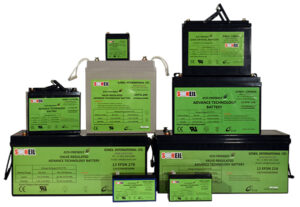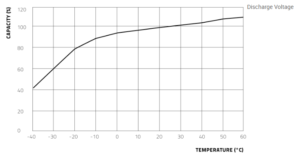 Many places in North America are experiencing cold snaps this time of year. Extreme temperatures can decrease performance or cause damage and failure to most batteries.
Many places in North America are experiencing cold snaps this time of year. Extreme temperatures can decrease performance or cause damage and failure to most batteries.
If you are using batteries for off-grid, RV or backup power, or are planning to start, it is important to know what batteries can withstand extreme temperatures. Azimuth Solar’s Silicon Dioxide (Lead Crystal) batteries provide outstanding performance in extreme hot and cold weather conditions, faster charging and over 10 year lifespans, at lower lifetime costs.
Silicon Dioxide batteries (aka SiO2, Lead Crystal, or just Crystal batteries) are built to last in rough conditions. These batteries can be discharged deeper, cycled more often (even in extreme temperatures), charge faster and have longer lifespans. They recover to full-rated capacity. They do not require maintenance, special ventilation or cooling, and can be stored up to 2 years without recharge.
Extreme Cold Performance
Lead Acid batteries will freeze at -25C/-13F at 50% charge. The more you power you take from the battery, the easier it is to freeze and damage. Once a battery has frozen, you cannot use it until it is slowly defrosted and checked. This usually kills the battery. Lead Acid batteries can have lower freezing temperature ratings, but that is only helpful if you don’t plan on using them. The freezing point of Lead Acid batteries rises as their charge level drops. If you need a battery during an ice storm or winter blackout, you may not be able to use your Lead Acid batteries when you need them the most.
SiO2 batteries do not suffer from freezing damage and retain more available power at lower temperatures.
A Lead Acid battery at -30C/-22F has only 50% available capacity and you can access only 40% of that before it freezes. For example, a 100Ah battery becomes a 50Ah battery at -30C/-22F. You can only use 40% (20Ah) of that capacity before it freezes. At this temperature your available power is 20Ah if the battery is fully charged to begin with.
SiO2 batteries will have reduced capacity at low temperatures, but not the freezing limitations. You can use up to 100% of the available capacity of a SiO2 Battery. For example, at -30C/-22F, a 100Ah SiO2 battery retains 60% capacity, so will have 60Ah of available power (3x power vs. Lead Acid).
SiO2 batteries also outperform most batteries at high temperatures. They are rated to +65C/149F vs, 45-50C/113-122F for Lead Acid. Lead Acid batteries off-gas Hydrogen and Oxygen at high temperatures, an explosive mix that needs to be vented. Flooded batteries require fluid replacement.
Unique Chemistry
The SiO2 technology is unique. Standard Lead Acid batteries suffer from freezing, poor low & high temperature performance, sulfation/corrosion, water loss, off-gassing, transport safety issues and short life cycles. The non-corrosive electrolyte in SiO2 batteries forms crystalline salts when charged/discharged. SiO2 batteries use 95% less sulphuric acid than Lead Acid batteries. They are essentially a “dry-cell” battery with no liquid to freeze, spill or off-gas. Eliminating most of the acid, means that the lead plates last longer and weigh less. Sulphation does not build-up and reduce capacity over time. With the crystalline structure, they can also be used in any orientation.
Longer Lasting
SiO2 Batteries last 2-5X as long as Lead Acid batteries. Deep-cycle Lead Acid batteries are rated from 500 charge/discharge cycles (discount batteries) to 1200 cycles for premium batteries, at 50% depth of discharge levels (DoD). The SiO2 batteries offer a much higher cycle life of 2800 cycles at 50% DoD. Their lifetime cost per cycle averages 1/2 to 1/3 of most deep-cycle batteries.
High Current Discharge Ability
SiO2 batteries have excellent high-current discharge ability and will not suffer any capacity loss when discharged to 100%. The Silicon Dioxide batteries have a rapid charging time in comparison to conventional alternatives. At 25C a 100Ah battery can be charged at 25A per hour resulting in a 4 hour charge time (20-40% faster than AGM and Lead Acid batteries, which typically charge at 15-20C which is 5-7 hours for a 100Ah battery). In practical terms, if you are using a fuel generator to recharge your batteries, you will need to run it 20-40% less with SiO2 batteries, than with Lead Acid batteries.
Environmentally Friendly
Because the SiO2 batteries have less Acid, no cadmium, no antimony, the batteries are up to 99% recyclable and are classified as non-hazardous goods for transport. These batteries are a sustainable, environmentally-friendly, less-toxic option using about ¼ of the resources of regular Lead Acid batteries.
Wide Range of Uses

They have almost no off-gassing and are well suited for marine use and in enclosed spaces, such as RVs and campers. They are widely used by Telecoms due to their long life span, and extreme temperature resilience. SiO2 batteries are available in a wide range of sizes and voltages, even up to 270Ah 12V 8D batteries and do not require a Battery Management System.



For a 2012 Honda CR-V
Just a quick note that this has been seen and we’re looking into it. Will have an answer for tomorrow!
So you’re looking for a G51R battery. The closest ULL size would be a 12V 50Ah EFSL. I’m getting pricing on that from the manufacturer and will place the item on both websites when I do! I will send a follow-up email too.
Send me a catalog or output and pricing information to Big Rock Comp 668 Sterling Rd Sterling conn 06354
Hi there! Sending an e-mail with more info. We don’t have a physical catalog, just our digital store: http://azimuthsolarproducts.com/product-category/batteries/ull/
Are these suitable for electric trolling motors? I have a 36 volt and 24 volt trophy motor and I’m thinking about replacing my MARINE batteries this spring. I have the 27 series and I taking quotes on replacing them. In the event your batteries would be applicable for my application, would you please provide a price quote for 5 batteries including fright costs.
Absolutely, the ULL batteries would work just fine. You’d want the 12V 100Ah: http://azimuthsolarproducts.com/product/ultra-long-life-battery/. Sending you an e-mail shortly to get more info!